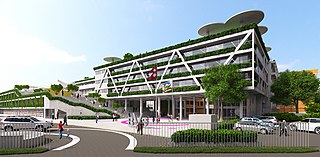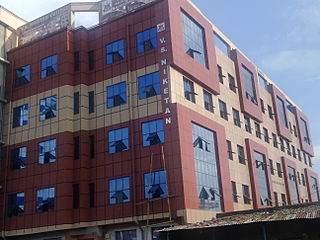
Matriculation is the formal process of entering a university, or of becoming eligible to enter by fulfilling certain academic requirements such as a matriculation examination.

Budhanilkantha School, often referred to as BNKS, is a competitive non-profit boarding school in Nepal. It is located in Narayanthan, 8 kilometres north of Kathmandu, at the foothills of Shivapuri mountain (2,732 m [8,963 ft]). It is named after the Budhanilkantha Temple, which is located nearby.

Education in Nepal has been modeled on the Indian system, which is in turn the legacy of the old British Raj. The National Examinations Board (NEB) supervises all standardized tests. The Ministry of Education is responsible for managing educational activities in Nepal. The National Center for Educational Development (NCED) is Nepal's teacher-training body.
Kathmandu University High School (KUHS) is a high school in Chaukot, Panauti, in the Kavrepalanchok District, Nepal. Kathmandu University High School, initially named as Kathmandu University Preparatory School was established in 1998 A.D. with only 60 primary students from local areas and children of the staffs of Kathmandu University. The School started in a rented building near by a beautiful place called Bansghari in Dhulikhel with few staff by Mr. Aiden Warlow as a principal. The school always has been a non-profit making organization established under the umbrella of Kathmandu University.

Gandaki Boarding School, , formerly known as Nepal Adarsha Bidyashram, is a model boarding school of Nepal, established on 11 June 1966 in the city of Pokhara, 200 kilometers west of Kathmandu. It is the first and the only regional school of the country. It was established as a result of the initiation of three groups - The United Mission to Nepal, The Shining Hospital, and the local community.

The A-level is a subject-based qualification conferred as part of the General Certificate of Education, as well as a school leaving qualification offered by the educational bodies in the United Kingdom and the educational authorities of British Crown dependencies to students completing secondary or pre-university education. They were introduced in England and Wales in 1951 to replace the Higher School Certificate. The A-level permits students to have potential access to a chosen university they applied to with UCAS points. They could be accepted into it should they meet the requirements of the university.
The School Leaving Certificate popularly abbreviated as SLC, is the final examination of Class 11 and Class 12 which is also known as +2 course in Nepal. A +2 course is generally pursued after completing Secondary Education Examination (SEE).
The Nepal Police School usually shortened as “NPS”, previously known as Dipendra Police School (DPS) named after the late Crown Prince Dipendra Bir Bikram Shah of The Kingdom of Nepal is a regional system of police boarding schools in Nepal. The school motto is “Better Schooling for ideal Citizens”. The schools predominantly accept applications from children of Nepal police personnel but in some cases accept applications from non-police personnel children. Prospective students sit entrance exams as part of the admissions process. These schools are funded by the welfare program of the Nepal Police Organisation. The school's history, reputation for discipline, and holistic approach to education with a special focus on physical education and athletics cause this school to be considered one of Nepal's most reputable schools.
10+2 refers to the 2 years of schooling which is required post grade 10, adopted by high schools in Nepal. 10+2 is gradually replacing the conventional modes of intermediate education, being the Intermediate of Science, Intermediate of Commerce, Intermediate of Arts/Humanities normally taken by Students after having received their School Leaving Certificate (SLC) provided by Tribhuvan University. Students in Nepal either opt for a 10+2 course in the science, management, and humanities stream under the Higher Secondary Education Board (HSEB), or opt for other options like the British A-Levels curriculum under Cambridge University.

Brihaspati VidyaSadan is a school in Kathmandu, Nepal. It was established with 59 students. The first principal was Morris Benerjee followed by Ananda Gurung. Initially, the school was located at Dhobi Khola. In 1986 the school moved from Dhobi Khola to Naxal, in front of Police Headquarters. The first batch of students took the School Leaving Certificate Examination (SLC) in 1990. In 1991, French was introduced as the third language besides English and Nepali. In 2007-08 10+2 level in science stream was added to the existing management stream. In 2008-09 the school also started The University of Cambridge(CIE) A Levels Program along with existing SLC and 10+2 level programs.

V.S. Niketan Higher Secondary School is located in Minbhawan Kathmandu, Nepal and schools above 40,00 Current students. V.S. Education Foundation is the outcome of the expansion of an education system aiming to coordinate all the educational activities of the institution so that the entity established at V.S. Niketan is uniformly maintained in all levels of teaching and learning under the same roof. The institution function form Pre-Primary to Bachelor's Levels of education. It has been awarded the "Best School of Nepal" for two times, recently.
Advance Learners Himalayan English Boarding Secondary School, often referred as "Advance" or "ALHEBS" School is a private school in Jaleshwar, Nepal.
The National School of Sciences (NSS) formerly known as the National Institute of Science and Technology (NIST), was established in 1993. It is located in Lainchour, Kathmandu, Nepal. The patron of the institute is Madhav Prasad Baral, who is also the academic in charge and similarly vice principal is Pranita Sharma Baral.The school offers science and management courses, primarily focusing on science. The institute is a part of a larger NIST Foundation which has multiple other branches which offer education from the secondary level up to the graduate levels.

GEMS (Graded English Medium School) is a private school, established in 1984 AD in Lalitpur, Nepal, 1.5 kilometers from Satdobato point on the Ring road, running classes from grades 1 to 10. Owing to its long history of teaching experience, the school has long been regarded as one of the best in the country.

'National Examinations Board is the board that organizes the Higher Secondary examination and education in Nepal. It is transformed from previous Higher Secondary Education Board (HSEB) according to the Education Act of 2073 B.S. It is located in Sanothimi, Bhaktapur. It is the main body that organises board exams. Its main aim is to prepare skilled human power for the development of the country.

Godawari Vidhya Mandir is one of the oldest schools in Itahari, Nepal. Established in 1992 AD the HSEB-affiliated school has an enrollment of over 1200 students.

Shree Amarsingh Secondary School is a secondary school opened from amount collected from post war reconstruction fund established after World War as Soldier's Board Vocational Training High School on March 26, 1957. After 10 years it was handed over to Government of Nepal on September 14, 1966 and renamed to its present name.
Singha Bahini Higher Secondary School is a public school situated at Myanglung-2, Terhathum in eastern Nepal. It is affiliated under Higher Secondary Education Board.
Premier Secondary School is a boarding school in Rajbiraj, Nepal. The school was established in 1998. The founder of the school is Rajesh Karna. The school has around 500 students. It is one of the school who produces reasonable percentage of results in School Leaving Certificate exams. Abhishek Shrivastav from the school topped Saptari district in SLC 2072 BS and get awarded by PABSON. The school provides qualitative education to all the studying students.
The Secondary Education Examination (SEE) is the final examination in the secondary school system of Nepal which is being taken by National Examination Board. National Examination Board upgraded from what was previously known as School Leaving Certificate (SLC).










